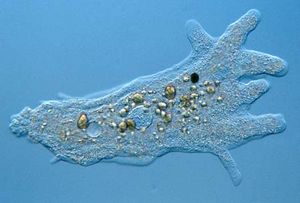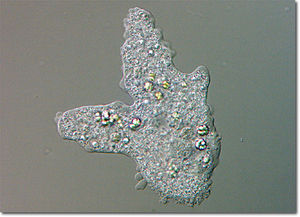Ameba
A Microbial Biorealm page on the genus Ameba

Classification
Higher order taxa:
Eukaryota; Lobosea; Euamoebida; Amoebidae
Species:
Entamoeba histolytica, B. mandrillaris, Acanthamoeba castellanii
|
NCBI: Taxonomy Genome |
Description and Significance
Amoebae are polyphyletic organisms. They are considered the simplest eukaryotes. Amoebic evolutionary history extends back to the Proterozoic era. However, fossil amebas are rare. Some of them are free-living, some of them are commensalists, some are obligate parasites, and some are opportunistic parasites.
Genome Structure
Loftus et. al. (2005) mapped the genome of the species Entamoeba histolytica. Their research shows that this species has a great deal in common with the pathogenic organisms Giardia lamblia and Trichomonas vaginalis, such as the use of oxidative stress enzymes. The genome of Entamoeba histolytica encodes novel receptor kinases and expands on numerous gene families. This genome also has tandemly repeated transfer-RNA-containing arrays.
Cell Structure and Metabolism

Amebas are unicellular organisms consisting mainly of cytoplasm and a flexible cell wall. The cytoplasm is capable of changing states. The amoeboid body form is not unique to amoeba. Many other types of organisms, such as algae, have similar strucutres. They have adaptive forms. Amebas use pseudopodia for both locomotion and obtaining food. Most species do not have flagella, but some go through a flagellate phase. Some species of amebas have a shell, called a test. These amebas are known as Testate Amebas. Amebas without testates are referred to as Naked Amebas. The species Entamoeba histolytica does not have a mitochondria or cytochrome system. Some of the research focusing on the pathogenicity of amebas has inidicated that differences in cell composition may result in making certain species pathogenic and other species non- pathogenic. Research by Campos-Rodríguezp and Jarillo-Luna (2005) suggests that paothogenicity is partially determined by properties and composition of the surface coat. Research by Tavares et. al. (2005) shows that the species Entamoeba histolytica has a dynamic actomyosin cytoskeleton that aids in its ability to infect host organisms.
Amebas are heterotrophic organisms that feed on bacteria. In addition, some species feed on algae, plant cells, protozoa, and metazoa. In the case of parasitic amebas, the organism will take nutrients from its host.
Amebas grow and then divide. Depending on the species, there may be a transition from asexual to sexual states. Parasitic amebas have simple life cycles. They are transmitted from host to host in a free-living resistant stage called a cyst. Once it has a host, the wall around the cyst disappears. The nucleus divides twice. The organism then enters the trophic stage. It then enters a pre-cyst stage to prepare to transfer to another host. In this stage, the organism forms a glycogen vacuole and chromatin bars, as well as an outer wall, which will be again removed once a host is found.
Ecology

Amoebas can form multiples types of relationships: commensalistic, obligate, and opportunistic. Others are free-living. Most obligate parasites infect the digestive tracts of their hosts. Amebas can be found in both freshwater and marine habitats. Some amebas are found in soil and feed off of the bacteria in those habitats. It is believed that in doing so, the amebas ensure nutrient regeneration.
Many amebas are parasitic and pathogenic. For example, the species Balamuthia mandrillaris causes granulomatous amebic encephalitis (GAE) in mammals. This and other species also form symbiotic relationships with bacteria, such as Legionella pneumophila, which causes Legionnaires' disease. The pathogenicity of both the amebas and the bacteria are intensified in these relationships. Another species, Entamoeba histolytica, causes amoebic colitis and liver abscesses. This organism infects its host through adherence, contact-dependent cytolysis, and phagocytosis. In addition, it can develop resistances to nitroimidazoles, which are currently considered the most effective drugs. Current research is often devoted to finding a better treatment method. The work of Ordaz-Pichardo et. al. (2005) suggests that ethyl 4-chlorophenylcarbamate (C4) may be a more reliable option. Other amebas cause diseases such as amoebic gill disease (AGD), which affects fish. AGD currently is the main disease affecting the salmon industry in Tasmania. Although research has been done on how to reduce the risk of AIG, it has nonetheless been difficult to determine the specific risk factors for this disease.
Some ameba species are susceptible to a serum derived from the American alligator (Alligator mississippiensis). The research of Merchant et. al. (2004) illustrates that the species Naegleria gruberi, as well as two other Naegleria speices and four Acanthamoeba species were not resistant to the effect of this serum.
References
Capuano, Christina. Soil Microbiology.
Col, Jeananda. "Amoeba (Ameba)." Enchanted Learning.com.
